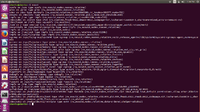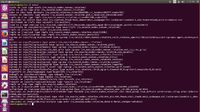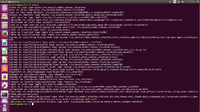You are using an out of date browser. It may not display this or other websites correctly.
You should upgrade or use an alternative browser.
You should upgrade or use an alternative browser.
Raspberry Pi 3
- Thread starter Ian J
- Start date
levi
Still fresh, damnit!
Yes, still mounted read-write all the way, so it's not the way it's mounted that's the problem, and it's not falling over because of corruption (either real, or driver issues). Presumably there's some error that appears when trying to copy files on - can you remember the exact text of the errors?
levi
Still fresh, damnit!
Ah okay, /media/ubuntu/retropi is an ext4 partition, and will likely have different user ids to your live users which gives you these sort of problems. For example, you're logged in as user 1001, but the directories on the disc are owned by user 1002, so user 1001 can't write files if the directory is not all-writable.
I'm not sure of the best way to resolve that issue, actually. I've always ended up sudo copying stuff on there (which results in stuff owned by root), then sudo chowning it back to the right user on the other side, but if you're copying a lot of different folders that could be impractical, and there really ought to be a better solution
I'm not sure of the best way to resolve that issue, actually. I've always ended up sudo copying stuff on there (which results in stuff owned by root), then sudo chowning it back to the right user on the other side, but if you're copying a lot of different folders that could be impractical, and there really ought to be a better solution
Ian J
Advanced Member
- Joined
- Aug 27, 2010
- Messages
- 1,880
I put Ubuntu MATE 16.04 on mine, it runs very well and is essentially a full computer.
Many thanks for your recommendation, I put this on a USB stick and used it to transfer the files above I was having issues with to my RPi SD cards without issue.
I'll stick with mint and try it on the Pi when I get the replacement power supply.
S
sulu
Guest
The best solution would be to get rid of the different UIDs altogether - either by making sure during installation that the UID of a user on the new system matches that of the same user on an old system, or by changing the UID of an existing user on the already installed system.Ah okay, /media/ubuntu/retropi is an ext4 partition, and will likely have different user ids to your live users which gives you these sort of problems. For example, you're logged in as user 1001, but the directories on the disc are owned by user 1002, so user 1001 can't write files if the directory is not all-writable.
I'm not sure of the best way to resolve that issue, actually.
I feel obliged to mention: Hardkernel also makes some single-board computers that can be interesting alternatives to the RPI. Depends on your use case of course, and look carefully before you buy. The older Odroid u3 I bought initially couldn't do hardware scaling of video under X, so pretty useless for my tv-set application. Eventually i got it sorted though.
http://www.hardkernel.com/main/main.php
Happy 2017 to all and here's hoping we'll see the Pyras arriving soon.
http://www.hardkernel.com/main/main.php
Happy 2017 to all and here's hoping we'll see the Pyras arriving soon.
MrConfusion
Very Active Member
- Joined
- Apr 11, 2013
- Messages
- 331
(ZZZZZ.... What, who, when... oh a PI... yeah, PIs are nice... in a kind of "PC industry made small" kind of way... cheap... lots of ready-to-install crap for sale with good instructions... 30 euros here, 30 there, 10 minutes of your time --> bang you got something neat and useful... huge userbase... not particularly niche or original, but nice still...I've set up a couple of MicroSD cards with emulators but I'm after some inspiration for what else to do.
...MrConfusion wakes from slumber...)
The only "kinda cool" and related thing I did with the PI was running a MIDI stream from Dosbox (running in the Pandora) to a PI3 running Munt... For kicks I ran through Monkey Island this way. PI was providing the sound via a speaker, but the Pandora was being completely wireless. No latency at all - MIDI streams being the tiny trickle they are measured in today's bitrates. There was something I suspected to be audible jitter between two notes every two hours of gaming or so and at least one dropped note I'm sure of... but come on, it's a game - who gives a....
...besides, if they were, it's due to Pandora's wifi being so... picky
So then a few weeks ago I got the crazy idea to try streaming the audio back to the Pandora... this sortakinda worked better than I thought - not much glitches, but a bit too much latency. (No coding involved - just named pipes and netcat). So I did an improvement: Bought a WifiN-stick for the Pandora and instead of the filewriter in munt, used the Alsa fileplugin to stream to the named pipe. This was successfull enough to warrant some cruelly ugly hotgluing in munt - I added a "-remote" command line switch so I never need to tinker with the UI to get this setup up and running... But again: you don't NEED to code to do this, it was up to the WiFistick and a modification to alsaconfig to get this far. The coding was purely for convenience. (I think...)
Still haven't played any actual games since then, but judging from pretty extensive tests I'll be enjoying some MT32 Roland sounds with my next Sierra game on the Pandora speakers - definitely less than a second of latency now
And don't say "meh, now you need to carry the PI with you", because that I've done for a while already: it's my mobile AP these days (running of a 20000mAh batterypack, it runs a solid 24 hours) - although my Pandora has 128 gigabytes of flash, the PI has all the MP3:s etc... Sitting in my backpack as a huge ball of a ducttaped box, zipties, plastic and vecro (readymade cases are for sissies ;-) it augments both my ereader and Pandora nicely and makes transfers between them quick and efficient. And the eink device and Pandora also play nice together, so a "headless hub" is the icing on the mobile cake.
It does nothing the Pandora couldn't handle, but you know: for less than 100 euros far too convenient to NOT build and utilize.
Every time I start a process in it with "nohup" just before leaving location X I think: This I would not do with my laptop, this is way cool.
But actually I have quite little experience of the PI in "heavy" desktop use, as in "OpenGL", etc... Firefox crashes a lot, but PDFs can be viewed and Vim and LaTeX work, which are about the only things I care about as far as the PI goes... when I have time to actually do something interesting, the Pandora is the The Interesting Thing getting my Attention
Well, after this wall of text, here's what you do, if you want to try this Munt thing (rough steps from memory):
On the Pandora:
modprobe vir-midi to get a midi loopback
netcat the /dev/midi1 to the PI (use UDP, TCP might work, but I suspect if it didn't, it would fail worse than UDP...)
(
Listen to audio from PI with netcat, stream it to aplay with a pipe.
Create an alsaconfig that mixes the received stream to main audio (so you hear SoundBlaster effects too
)
On the PI:
Compile Munt
create (two) named pipe(s): for midi (and audio)
Listen to midi coming from Pandora with netcat, then dump the stream to midi pipe.
Configure munt to listen the midipipe.
(
Create an alsaconfig that streams to the audio pipe.
Configure munt to stream the the alsa file plugin you just made.
Make netcat read the audio pipe and dump it to the Pandora (again: UDP probably works better).
)
As I didn't document anything while I tinkered and did about an hour at a time, it's hard to estimate how much time you end up using doing this. I know I had fun
Ranted... back to lurking... ;-)
ptitSeb
Serial Porter
that a nice setup! (you know dosbox in dbgl pnd has MUNT integrated, but it sure is much less fun to setup than the rPI as coprocessor for the Pandora  ).
).
MrConfusion
Very Active Member
- Joined
- Apr 11, 2013
- Messages
- 331
Well there's also the CPU munching aspect of Munt. I never tried the Dosbox integrated version in the Pandora, but standalone it seemed to eat the CPU for breakfast... netcat is far easier on the CPU ;-).
But yeah, not totally practical: suppose the Pyra were released before I have time to utilize the audio streaming setup... then it would never be utilized .
.
But yeah, not totally practical: suppose the Pyra were released before I have time to utilize the audio streaming setup... then it would never be utilized
ptitSeb
Serial Porter
On the CPU side, MUNT can eat quite some of what the Pandora can offer. But for adventure games like Sierra ones, it's fine. It's not ok for action games.
levi
Still fresh, damnit!
Luckily, it seems easier to change the uid and gid of existing users that I had expected, thanks to usermod automatically chowning stuff in your home directory so that you can still access it fine. If you've got stuff owned outside of your home directory then it's up to you to gain superuser privs and set chown them yourself, but I don't think it's very common to have user owned stuff outside of home. I'll have to remember that next time I'm plugging in an SD card or hard disc with an ext filesystem on it.The best solution would be to get rid of the different UIDs altogether - either by making sure during installation that the UID of a user on the new system matches that of the same user on an old system, or by changing the UID of an existing user on the already installed system.
linx
Still Fresh
- Joined
- May 12, 2014
- Messages
- 29
Both pi2`s are doing cctv motion work. One has a pinoir and IR lamps and the other is just a regular pi cam with a 4" touch screen on it. I set up pikrelcam for both ( excellent software )
Pi3 is running my Ikeatable top arcade machine and another pi3 is a dedicated Amiga one.
So I have a spare one going into a magic mirror
Have you tried streaming that video?
(ZZZZZ....
Ranted... back to lurking... ;-)
I'd like to see that ball of duct tape, battery pack, velcro! Just getting ideas on how to incorporate my mess.
Stainy
Advanced Member
What video?
Have you tried streaming that video?
I'd like to see that ball of duct tape, battery pack, velcro! Just getting ideas on how to incorporate my mess.
linx
Still Fresh
- Joined
- May 12, 2014
- Messages
- 29
What video?
of the CCTV Pis you have set up.
Stainy
Advanced Member
Oh right... yes it streams fine 
I did have ti change some motion settings on the pinoir one as there is more noise at night with my IR lamps.. so I had to tone it down a bit.
[doublepost=1485005982,1485005898][/doublepost]This is my next Pi project .
Also buying the one or two bits for my magic mirror
I did have ti change some motion settings on the pinoir one as there is more noise at night with my IR lamps.. so I had to tone it down a bit.
[doublepost=1485005982,1485005898][/doublepost]This is my next Pi project .
Also buying the one or two bits for my magic mirror
Wally
I am a banana!
exagear works great, they have guides to setup skype.
But your friend probably could also use the skype web interface or a phone with skype instead of hauling the Pi around
But your friend probably could also use the skype web interface or a phone with skype instead of hauling the Pi around
Ian J
Advanced Member
- Joined
- Aug 27, 2010
- Messages
- 1,880
I suggested using his phone but he's only taking a basic phone with him but needs access to his bank account to make money transfers.exagear works great, they have guides to setup skype.
But your friend probably could also use the skype web interface or a phone with skype instead of hauling the Pi around




